Assessing Questionnaire Effectiveness: Patient Safety in Healthcare
VerifiedAdded on 2022/08/22
|9
|2432
|13
Report
AI Summary
This report evaluates a close-ended questionnaire designed to measure the attitudes of hospital employees regarding patient safety. The assignment assesses the questionnaire's effectiveness based on its different sections (A-I), considering factors like work area, supervisor influence, communication, error reporting frequency, and overall patient safety grade. The report examines the strengths and weaknesses of each section, citing relevant research to support its analysis. The evaluation considers the use of close-ended questions and the inclusion of an open-ended questionnaire for more detailed insights. The conclusion highlights the overall effectiveness of the questionnaire while suggesting potential improvements, such as incorporating sections to assess theoretical knowledge about patient safety.
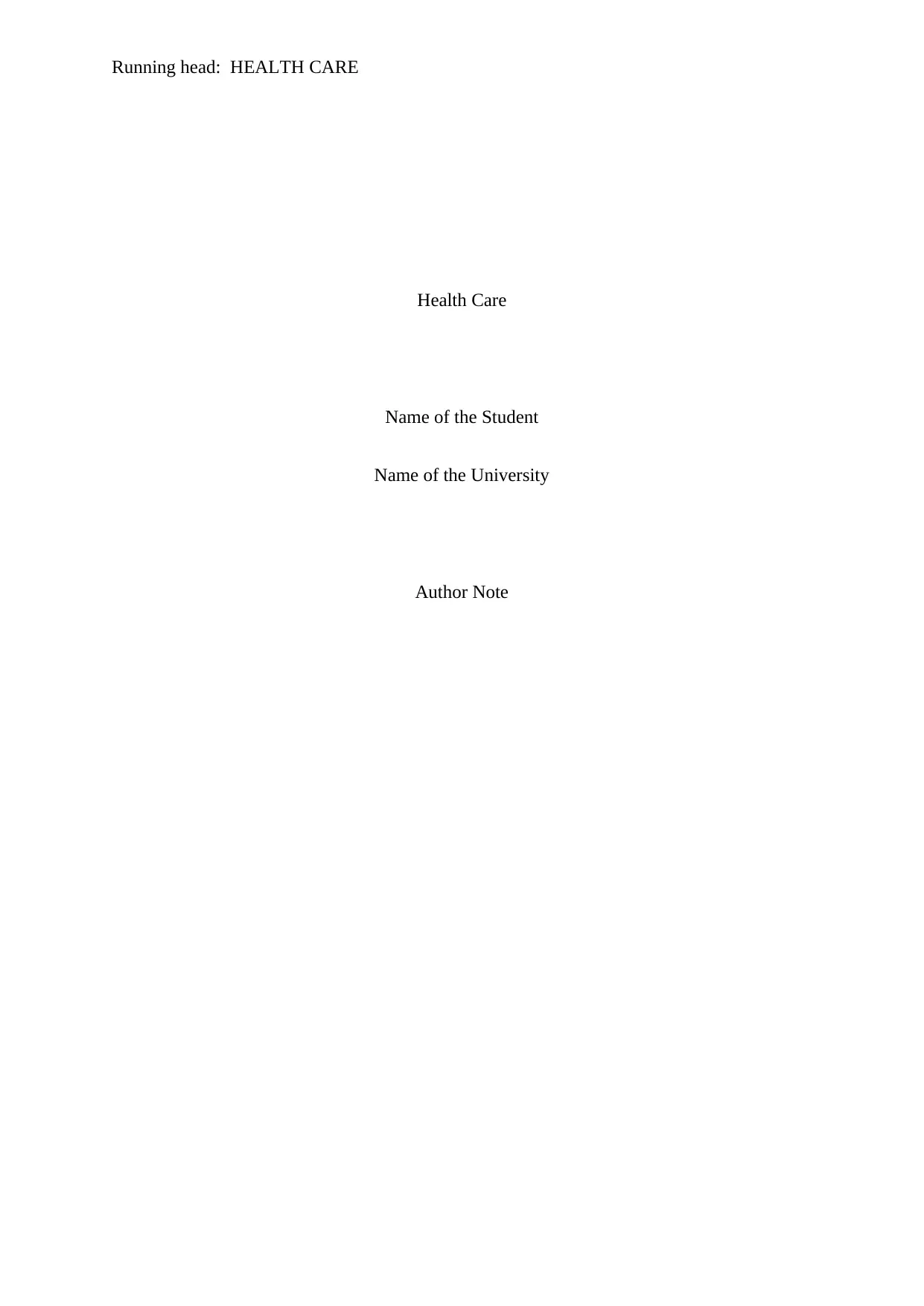
Running head: HEALTH CARE
Health Care
Name of the Student
Name of the University
Author Note
Health Care
Name of the Student
Name of the University
Author Note
Paraphrase This Document
Need a fresh take? Get an instant paraphrase of this document with our AI Paraphraser
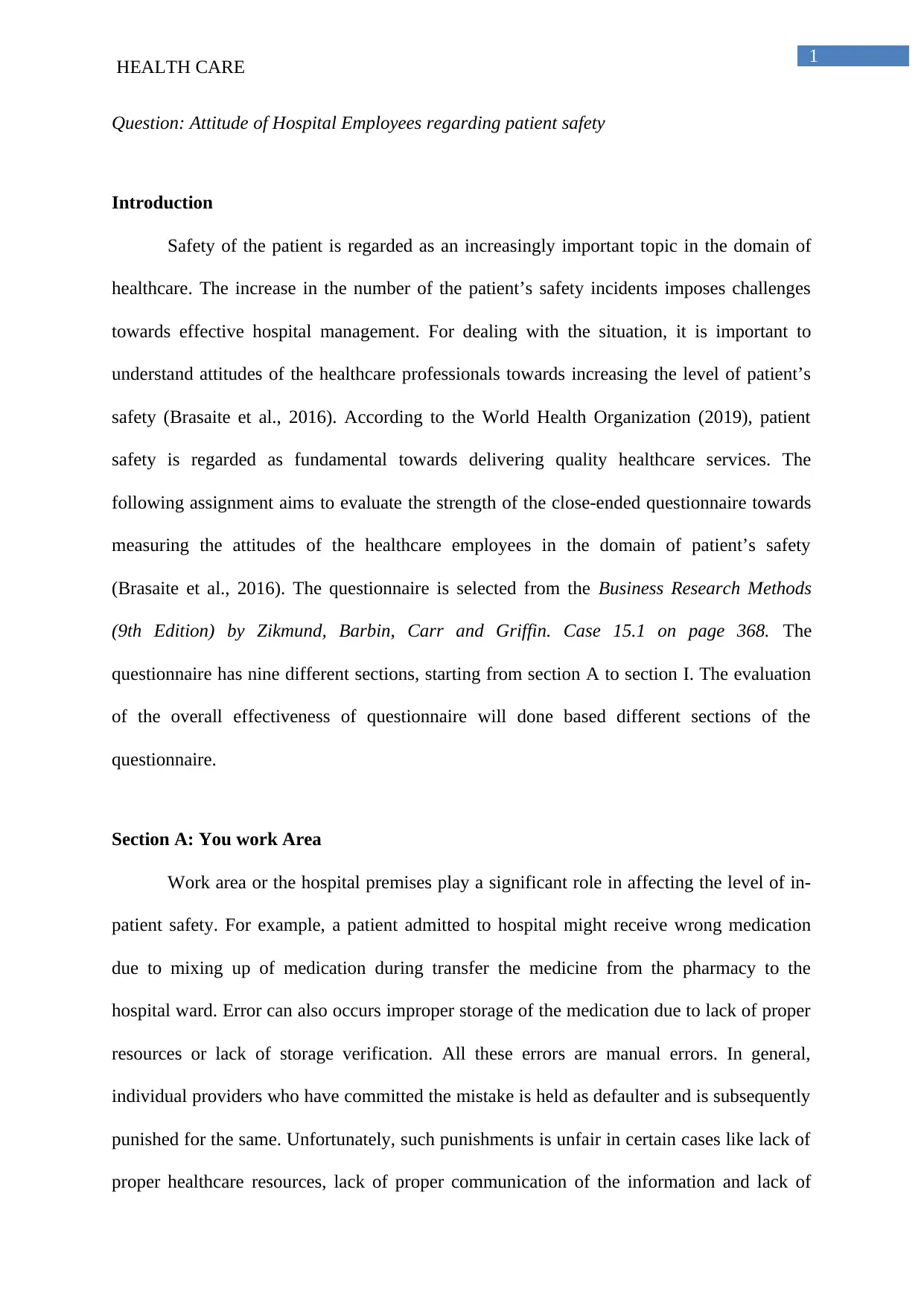
1
HEALTH CARE
Question: Attitude of Hospital Employees regarding patient safety
Introduction
Safety of the patient is regarded as an increasingly important topic in the domain of
healthcare. The increase in the number of the patient’s safety incidents imposes challenges
towards effective hospital management. For dealing with the situation, it is important to
understand attitudes of the healthcare professionals towards increasing the level of patient’s
safety (Brasaite et al., 2016). According to the World Health Organization (2019), patient
safety is regarded as fundamental towards delivering quality healthcare services. The
following assignment aims to evaluate the strength of the close-ended questionnaire towards
measuring the attitudes of the healthcare employees in the domain of patient’s safety
(Brasaite et al., 2016). The questionnaire is selected from the Business Research Methods
(9th Edition) by Zikmund, Barbin, Carr and Griffin. Case 15.1 on page 368. The
questionnaire has nine different sections, starting from section A to section I. The evaluation
of the overall effectiveness of questionnaire will done based different sections of the
questionnaire.
Section A: You work Area
Work area or the hospital premises play a significant role in affecting the level of in-
patient safety. For example, a patient admitted to hospital might receive wrong medication
due to mixing up of medication during transfer the medicine from the pharmacy to the
hospital ward. Error can also occurs improper storage of the medication due to lack of proper
resources or lack of storage verification. All these errors are manual errors. In general,
individual providers who have committed the mistake is held as defaulter and is subsequently
punished for the same. Unfortunately, such punishments is unfair in certain cases like lack of
proper healthcare resources, lack of proper communication of the information and lack of
HEALTH CARE
Question: Attitude of Hospital Employees regarding patient safety
Introduction
Safety of the patient is regarded as an increasingly important topic in the domain of
healthcare. The increase in the number of the patient’s safety incidents imposes challenges
towards effective hospital management. For dealing with the situation, it is important to
understand attitudes of the healthcare professionals towards increasing the level of patient’s
safety (Brasaite et al., 2016). According to the World Health Organization (2019), patient
safety is regarded as fundamental towards delivering quality healthcare services. The
following assignment aims to evaluate the strength of the close-ended questionnaire towards
measuring the attitudes of the healthcare employees in the domain of patient’s safety
(Brasaite et al., 2016). The questionnaire is selected from the Business Research Methods
(9th Edition) by Zikmund, Barbin, Carr and Griffin. Case 15.1 on page 368. The
questionnaire has nine different sections, starting from section A to section I. The evaluation
of the overall effectiveness of questionnaire will done based different sections of the
questionnaire.
Section A: You work Area
Work area or the hospital premises play a significant role in affecting the level of in-
patient safety. For example, a patient admitted to hospital might receive wrong medication
due to mixing up of medication during transfer the medicine from the pharmacy to the
hospital ward. Error can also occurs improper storage of the medication due to lack of proper
resources or lack of storage verification. All these errors are manual errors. In general,
individual providers who have committed the mistake is held as defaulter and is subsequently
punished for the same. Unfortunately, such punishments is unfair in certain cases like lack of
proper healthcare resources, lack of proper communication of the information and lack of
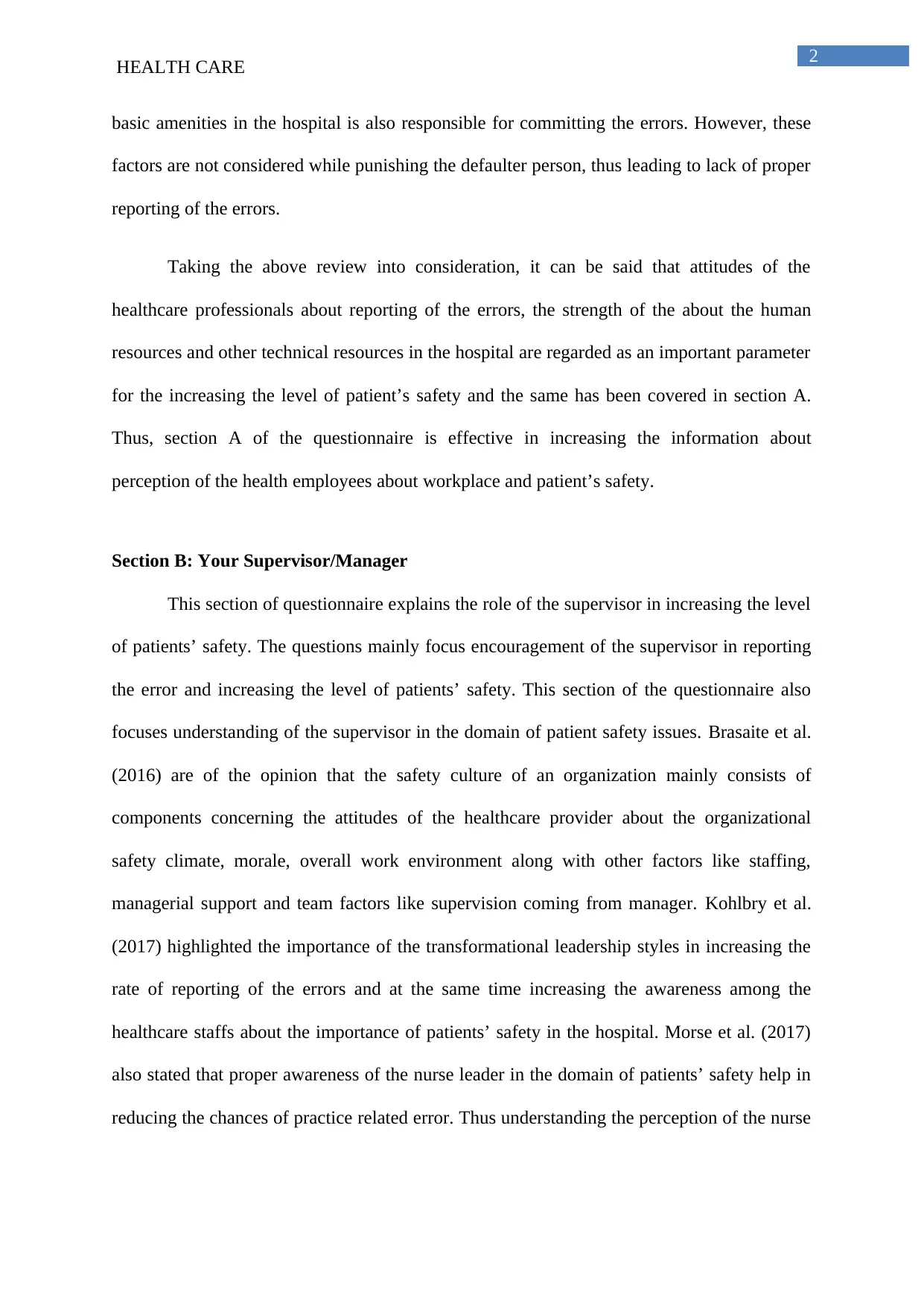
2
HEALTH CARE
basic amenities in the hospital is also responsible for committing the errors. However, these
factors are not considered while punishing the defaulter person, thus leading to lack of proper
reporting of the errors.
Taking the above review into consideration, it can be said that attitudes of the
healthcare professionals about reporting of the errors, the strength of the about the human
resources and other technical resources in the hospital are regarded as an important parameter
for the increasing the level of patient’s safety and the same has been covered in section A.
Thus, section A of the questionnaire is effective in increasing the information about
perception of the health employees about workplace and patient’s safety.
Section B: Your Supervisor/Manager
This section of questionnaire explains the role of the supervisor in increasing the level
of patients’ safety. The questions mainly focus encouragement of the supervisor in reporting
the error and increasing the level of patients’ safety. This section of the questionnaire also
focuses understanding of the supervisor in the domain of patient safety issues. Brasaite et al.
(2016) are of the opinion that the safety culture of an organization mainly consists of
components concerning the attitudes of the healthcare provider about the organizational
safety climate, morale, overall work environment along with other factors like staffing,
managerial support and team factors like supervision coming from manager. Kohlbry et al.
(2017) highlighted the importance of the transformational leadership styles in increasing the
rate of reporting of the errors and at the same time increasing the awareness among the
healthcare staffs about the importance of patients’ safety in the hospital. Morse et al. (2017)
also stated that proper awareness of the nurse leader in the domain of patients’ safety help in
reducing the chances of practice related error. Thus understanding the perception of the nurse
HEALTH CARE
basic amenities in the hospital is also responsible for committing the errors. However, these
factors are not considered while punishing the defaulter person, thus leading to lack of proper
reporting of the errors.
Taking the above review into consideration, it can be said that attitudes of the
healthcare professionals about reporting of the errors, the strength of the about the human
resources and other technical resources in the hospital are regarded as an important parameter
for the increasing the level of patient’s safety and the same has been covered in section A.
Thus, section A of the questionnaire is effective in increasing the information about
perception of the health employees about workplace and patient’s safety.
Section B: Your Supervisor/Manager
This section of questionnaire explains the role of the supervisor in increasing the level
of patients’ safety. The questions mainly focus encouragement of the supervisor in reporting
the error and increasing the level of patients’ safety. This section of the questionnaire also
focuses understanding of the supervisor in the domain of patient safety issues. Brasaite et al.
(2016) are of the opinion that the safety culture of an organization mainly consists of
components concerning the attitudes of the healthcare provider about the organizational
safety climate, morale, overall work environment along with other factors like staffing,
managerial support and team factors like supervision coming from manager. Kohlbry et al.
(2017) highlighted the importance of the transformational leadership styles in increasing the
rate of reporting of the errors and at the same time increasing the awareness among the
healthcare staffs about the importance of patients’ safety in the hospital. Morse et al. (2017)
also stated that proper awareness of the nurse leader in the domain of patients’ safety help in
reducing the chances of practice related error. Thus understanding the perception of the nurse
⊘ This is a preview!⊘
Do you want full access?
Subscribe today to unlock all pages.

Trusted by 1+ million students worldwide

3
HEALTH CARE
leaders is also important while studying the healthcare employees’ attitude towards patients’
safety.
Section C: Communication
Communication in the domain of patient’s safety deals with giving feedbacks and
ability to communicate freely for reporting of the error. Other aspects of communication that
are covered in this section include fear to report service related error or to clarify queries
associated with patient safety issues. Rutledge, Retrosi and Ostrowski (2018) stated that one
of the important barriers about timely reporting of the medication error is lack of proper
communication skills among the healthcare professionals. Rutledge, Retrosi and Ostrowski
(2018) further highlighted that the healthcare professional lack the proper inter-professional
skills that are important for reporting of the errors. Thus, assessment of the communication
skills of the healthcare professionals will help in estimating how communication plays an
important role in reducing practice error. Moreover getting knowledge about the
communication style and skills of the healthcare professionals will help to gain the
knowledge about their style of reporting of practice error that is associated with patient
safety.
Section D: Frequency of Events Reported
This section attempts to understand the frequency of reporting of the error under the
healthcare settings by the use of the close-ended questionnaire. Hutchinson et al. (2015)
stated that one of the important reasons behind increase in the rate of medication error under
the hospital setting is lack of proper reporting of the medication error by the nursing
professionals. Vrbnjak et al. (2016) stated that nursing professionals mainly fear losing their
job or experiencing suspension upon reporting of the error. The lack of proper reporting of
the practice related error endangers the level of patient’s safety and at the same time creates a
HEALTH CARE
leaders is also important while studying the healthcare employees’ attitude towards patients’
safety.
Section C: Communication
Communication in the domain of patient’s safety deals with giving feedbacks and
ability to communicate freely for reporting of the error. Other aspects of communication that
are covered in this section include fear to report service related error or to clarify queries
associated with patient safety issues. Rutledge, Retrosi and Ostrowski (2018) stated that one
of the important barriers about timely reporting of the medication error is lack of proper
communication skills among the healthcare professionals. Rutledge, Retrosi and Ostrowski
(2018) further highlighted that the healthcare professional lack the proper inter-professional
skills that are important for reporting of the errors. Thus, assessment of the communication
skills of the healthcare professionals will help in estimating how communication plays an
important role in reducing practice error. Moreover getting knowledge about the
communication style and skills of the healthcare professionals will help to gain the
knowledge about their style of reporting of practice error that is associated with patient
safety.
Section D: Frequency of Events Reported
This section attempts to understand the frequency of reporting of the error under the
healthcare settings by the use of the close-ended questionnaire. Hutchinson et al. (2015)
stated that one of the important reasons behind increase in the rate of medication error under
the hospital setting is lack of proper reporting of the medication error by the nursing
professionals. Vrbnjak et al. (2016) stated that nursing professionals mainly fear losing their
job or experiencing suspension upon reporting of the error. The lack of proper reporting of
the practice related error endangers the level of patient’s safety and at the same time creates a
Paraphrase This Document
Need a fresh take? Get an instant paraphrase of this document with our AI Paraphraser
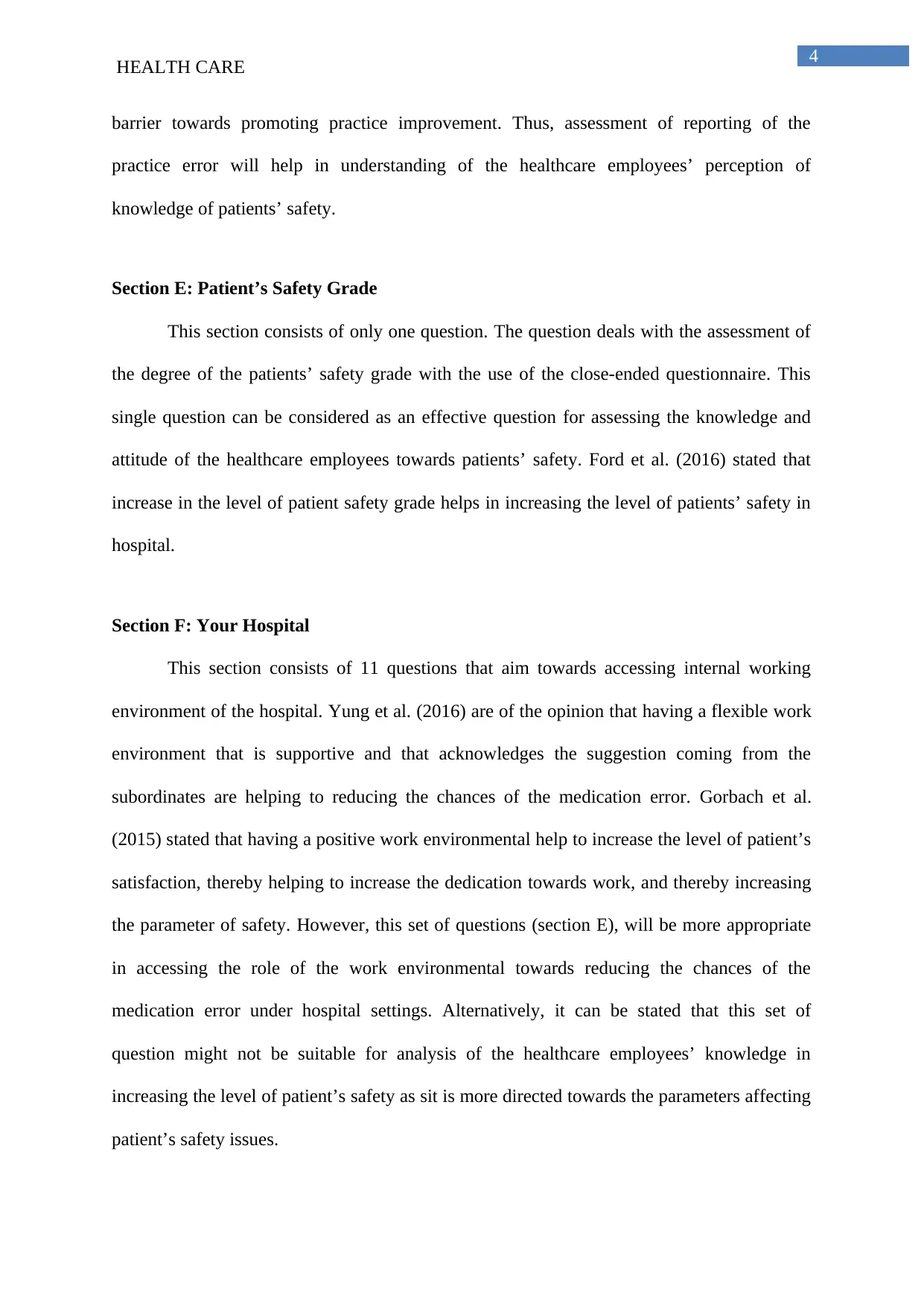
4
HEALTH CARE
barrier towards promoting practice improvement. Thus, assessment of reporting of the
practice error will help in understanding of the healthcare employees’ perception of
knowledge of patients’ safety.
Section E: Patient’s Safety Grade
This section consists of only one question. The question deals with the assessment of
the degree of the patients’ safety grade with the use of the close-ended questionnaire. This
single question can be considered as an effective question for assessing the knowledge and
attitude of the healthcare employees towards patients’ safety. Ford et al. (2016) stated that
increase in the level of patient safety grade helps in increasing the level of patients’ safety in
hospital.
Section F: Your Hospital
This section consists of 11 questions that aim towards accessing internal working
environment of the hospital. Yung et al. (2016) are of the opinion that having a flexible work
environment that is supportive and that acknowledges the suggestion coming from the
subordinates are helping to reducing the chances of the medication error. Gorbach et al.
(2015) stated that having a positive work environmental help to increase the level of patient’s
satisfaction, thereby helping to increase the dedication towards work, and thereby increasing
the parameter of safety. However, this set of questions (section E), will be more appropriate
in accessing the role of the work environmental towards reducing the chances of the
medication error under hospital settings. Alternatively, it can be stated that this set of
question might not be suitable for analysis of the healthcare employees’ knowledge in
increasing the level of patient’s safety as sit is more directed towards the parameters affecting
patient’s safety issues.
HEALTH CARE
barrier towards promoting practice improvement. Thus, assessment of reporting of the
practice error will help in understanding of the healthcare employees’ perception of
knowledge of patients’ safety.
Section E: Patient’s Safety Grade
This section consists of only one question. The question deals with the assessment of
the degree of the patients’ safety grade with the use of the close-ended questionnaire. This
single question can be considered as an effective question for assessing the knowledge and
attitude of the healthcare employees towards patients’ safety. Ford et al. (2016) stated that
increase in the level of patient safety grade helps in increasing the level of patients’ safety in
hospital.
Section F: Your Hospital
This section consists of 11 questions that aim towards accessing internal working
environment of the hospital. Yung et al. (2016) are of the opinion that having a flexible work
environment that is supportive and that acknowledges the suggestion coming from the
subordinates are helping to reducing the chances of the medication error. Gorbach et al.
(2015) stated that having a positive work environmental help to increase the level of patient’s
satisfaction, thereby helping to increase the dedication towards work, and thereby increasing
the parameter of safety. However, this set of questions (section E), will be more appropriate
in accessing the role of the work environmental towards reducing the chances of the
medication error under hospital settings. Alternatively, it can be stated that this set of
question might not be suitable for analysis of the healthcare employees’ knowledge in
increasing the level of patient’s safety as sit is more directed towards the parameters affecting
patient’s safety issues.
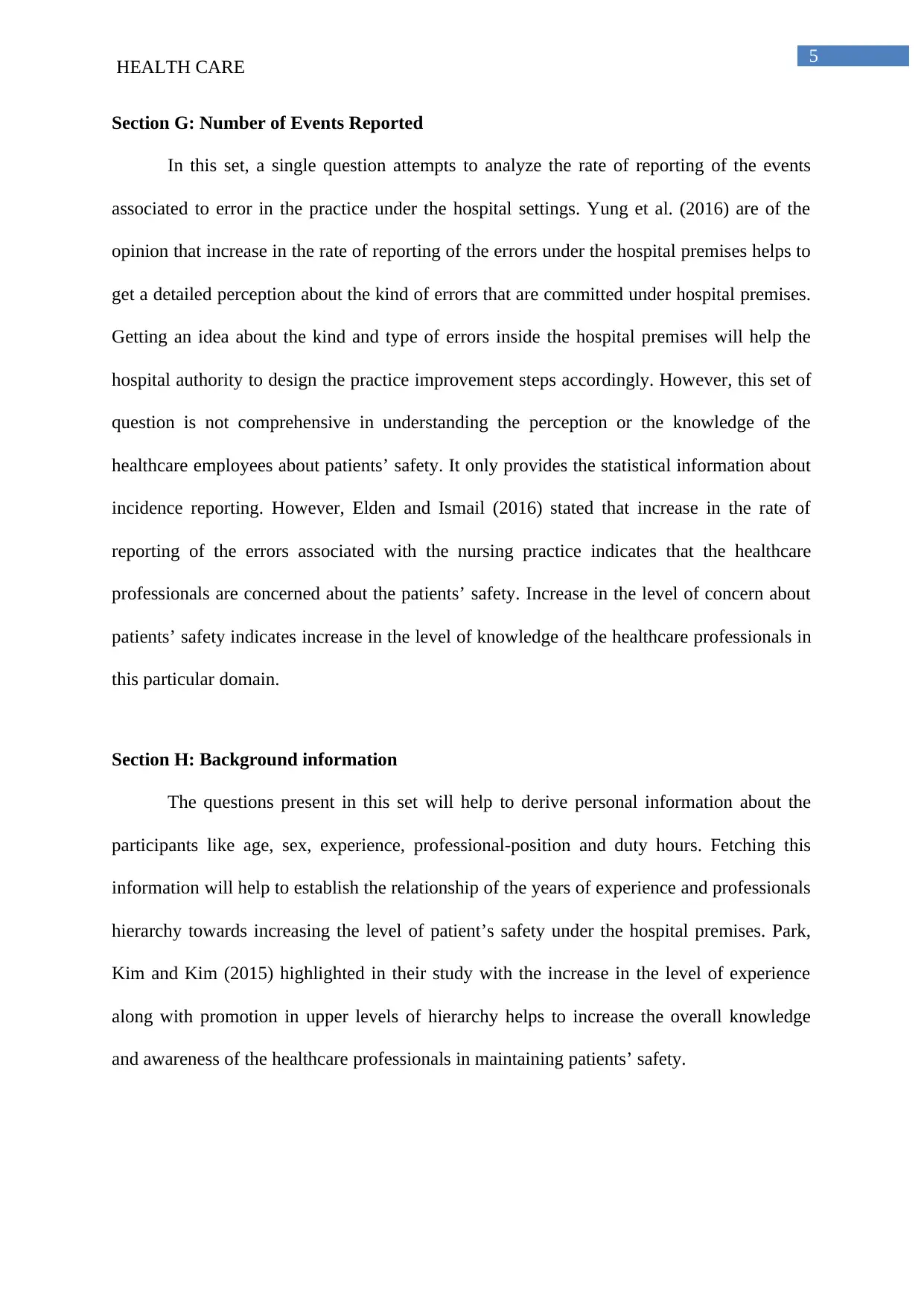
5
HEALTH CARE
Section G: Number of Events Reported
In this set, a single question attempts to analyze the rate of reporting of the events
associated to error in the practice under the hospital settings. Yung et al. (2016) are of the
opinion that increase in the rate of reporting of the errors under the hospital premises helps to
get a detailed perception about the kind of errors that are committed under hospital premises.
Getting an idea about the kind and type of errors inside the hospital premises will help the
hospital authority to design the practice improvement steps accordingly. However, this set of
question is not comprehensive in understanding the perception or the knowledge of the
healthcare employees about patients’ safety. It only provides the statistical information about
incidence reporting. However, Elden and Ismail (2016) stated that increase in the rate of
reporting of the errors associated with the nursing practice indicates that the healthcare
professionals are concerned about the patients’ safety. Increase in the level of concern about
patients’ safety indicates increase in the level of knowledge of the healthcare professionals in
this particular domain.
Section H: Background information
The questions present in this set will help to derive personal information about the
participants like age, sex, experience, professional-position and duty hours. Fetching this
information will help to establish the relationship of the years of experience and professionals
hierarchy towards increasing the level of patient’s safety under the hospital premises. Park,
Kim and Kim (2015) highlighted in their study with the increase in the level of experience
along with promotion in upper levels of hierarchy helps to increase the overall knowledge
and awareness of the healthcare professionals in maintaining patients’ safety.
HEALTH CARE
Section G: Number of Events Reported
In this set, a single question attempts to analyze the rate of reporting of the events
associated to error in the practice under the hospital settings. Yung et al. (2016) are of the
opinion that increase in the rate of reporting of the errors under the hospital premises helps to
get a detailed perception about the kind of errors that are committed under hospital premises.
Getting an idea about the kind and type of errors inside the hospital premises will help the
hospital authority to design the practice improvement steps accordingly. However, this set of
question is not comprehensive in understanding the perception or the knowledge of the
healthcare employees about patients’ safety. It only provides the statistical information about
incidence reporting. However, Elden and Ismail (2016) stated that increase in the rate of
reporting of the errors associated with the nursing practice indicates that the healthcare
professionals are concerned about the patients’ safety. Increase in the level of concern about
patients’ safety indicates increase in the level of knowledge of the healthcare professionals in
this particular domain.
Section H: Background information
The questions present in this set will help to derive personal information about the
participants like age, sex, experience, professional-position and duty hours. Fetching this
information will help to establish the relationship of the years of experience and professionals
hierarchy towards increasing the level of patient’s safety under the hospital premises. Park,
Kim and Kim (2015) highlighted in their study with the increase in the level of experience
along with promotion in upper levels of hierarchy helps to increase the overall knowledge
and awareness of the healthcare professionals in maintaining patients’ safety.
⊘ This is a preview!⊘
Do you want full access?
Subscribe today to unlock all pages.

Trusted by 1+ million students worldwide
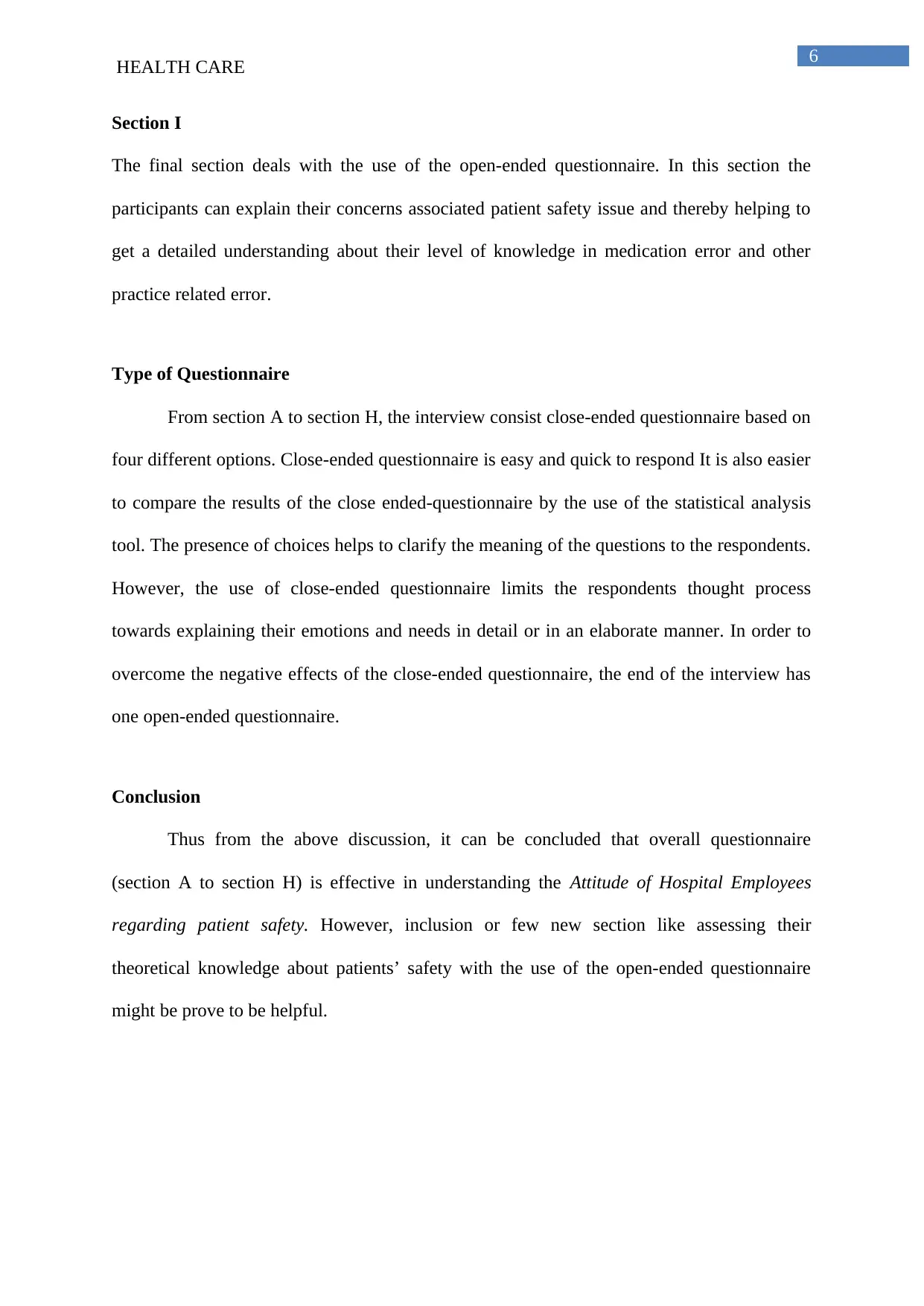
6
HEALTH CARE
Section I
The final section deals with the use of the open-ended questionnaire. In this section the
participants can explain their concerns associated patient safety issue and thereby helping to
get a detailed understanding about their level of knowledge in medication error and other
practice related error.
Type of Questionnaire
From section A to section H, the interview consist close-ended questionnaire based on
four different options. Close-ended questionnaire is easy and quick to respond It is also easier
to compare the results of the close ended-questionnaire by the use of the statistical analysis
tool. The presence of choices helps to clarify the meaning of the questions to the respondents.
However, the use of close-ended questionnaire limits the respondents thought process
towards explaining their emotions and needs in detail or in an elaborate manner. In order to
overcome the negative effects of the close-ended questionnaire, the end of the interview has
one open-ended questionnaire.
Conclusion
Thus from the above discussion, it can be concluded that overall questionnaire
(section A to section H) is effective in understanding the Attitude of Hospital Employees
regarding patient safety. However, inclusion or few new section like assessing their
theoretical knowledge about patients’ safety with the use of the open-ended questionnaire
might be prove to be helpful.
HEALTH CARE
Section I
The final section deals with the use of the open-ended questionnaire. In this section the
participants can explain their concerns associated patient safety issue and thereby helping to
get a detailed understanding about their level of knowledge in medication error and other
practice related error.
Type of Questionnaire
From section A to section H, the interview consist close-ended questionnaire based on
four different options. Close-ended questionnaire is easy and quick to respond It is also easier
to compare the results of the close ended-questionnaire by the use of the statistical analysis
tool. The presence of choices helps to clarify the meaning of the questions to the respondents.
However, the use of close-ended questionnaire limits the respondents thought process
towards explaining their emotions and needs in detail or in an elaborate manner. In order to
overcome the negative effects of the close-ended questionnaire, the end of the interview has
one open-ended questionnaire.
Conclusion
Thus from the above discussion, it can be concluded that overall questionnaire
(section A to section H) is effective in understanding the Attitude of Hospital Employees
regarding patient safety. However, inclusion or few new section like assessing their
theoretical knowledge about patients’ safety with the use of the open-ended questionnaire
might be prove to be helpful.
Paraphrase This Document
Need a fresh take? Get an instant paraphrase of this document with our AI Paraphraser
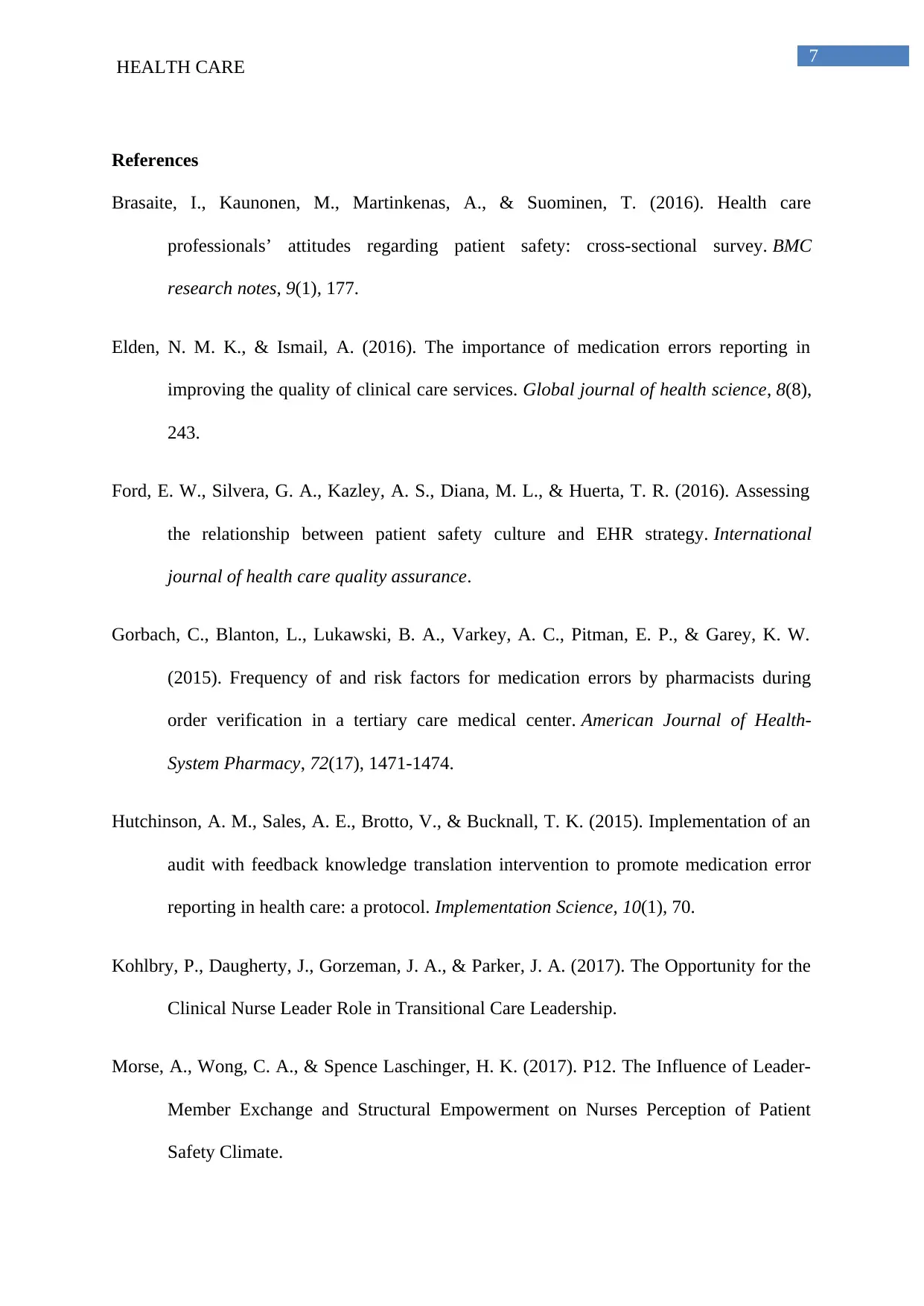
7
HEALTH CARE
References
Brasaite, I., Kaunonen, M., Martinkenas, A., & Suominen, T. (2016). Health care
professionals’ attitudes regarding patient safety: cross-sectional survey. BMC
research notes, 9(1), 177.
Elden, N. M. K., & Ismail, A. (2016). The importance of medication errors reporting in
improving the quality of clinical care services. Global journal of health science, 8(8),
243.
Ford, E. W., Silvera, G. A., Kazley, A. S., Diana, M. L., & Huerta, T. R. (2016). Assessing
the relationship between patient safety culture and EHR strategy. International
journal of health care quality assurance.
Gorbach, C., Blanton, L., Lukawski, B. A., Varkey, A. C., Pitman, E. P., & Garey, K. W.
(2015). Frequency of and risk factors for medication errors by pharmacists during
order verification in a tertiary care medical center. American Journal of Health-
System Pharmacy, 72(17), 1471-1474.
Hutchinson, A. M., Sales, A. E., Brotto, V., & Bucknall, T. K. (2015). Implementation of an
audit with feedback knowledge translation intervention to promote medication error
reporting in health care: a protocol. Implementation Science, 10(1), 70.
Kohlbry, P., Daugherty, J., Gorzeman, J. A., & Parker, J. A. (2017). The Opportunity for the
Clinical Nurse Leader Role in Transitional Care Leadership.
Morse, A., Wong, C. A., & Spence Laschinger, H. K. (2017). P12. The Influence of Leader-
Member Exchange and Structural Empowerment on Nurses Perception of Patient
Safety Climate.
HEALTH CARE
References
Brasaite, I., Kaunonen, M., Martinkenas, A., & Suominen, T. (2016). Health care
professionals’ attitudes regarding patient safety: cross-sectional survey. BMC
research notes, 9(1), 177.
Elden, N. M. K., & Ismail, A. (2016). The importance of medication errors reporting in
improving the quality of clinical care services. Global journal of health science, 8(8),
243.
Ford, E. W., Silvera, G. A., Kazley, A. S., Diana, M. L., & Huerta, T. R. (2016). Assessing
the relationship between patient safety culture and EHR strategy. International
journal of health care quality assurance.
Gorbach, C., Blanton, L., Lukawski, B. A., Varkey, A. C., Pitman, E. P., & Garey, K. W.
(2015). Frequency of and risk factors for medication errors by pharmacists during
order verification in a tertiary care medical center. American Journal of Health-
System Pharmacy, 72(17), 1471-1474.
Hutchinson, A. M., Sales, A. E., Brotto, V., & Bucknall, T. K. (2015). Implementation of an
audit with feedback knowledge translation intervention to promote medication error
reporting in health care: a protocol. Implementation Science, 10(1), 70.
Kohlbry, P., Daugherty, J., Gorzeman, J. A., & Parker, J. A. (2017). The Opportunity for the
Clinical Nurse Leader Role in Transitional Care Leadership.
Morse, A., Wong, C. A., & Spence Laschinger, H. K. (2017). P12. The Influence of Leader-
Member Exchange and Structural Empowerment on Nurses Perception of Patient
Safety Climate.
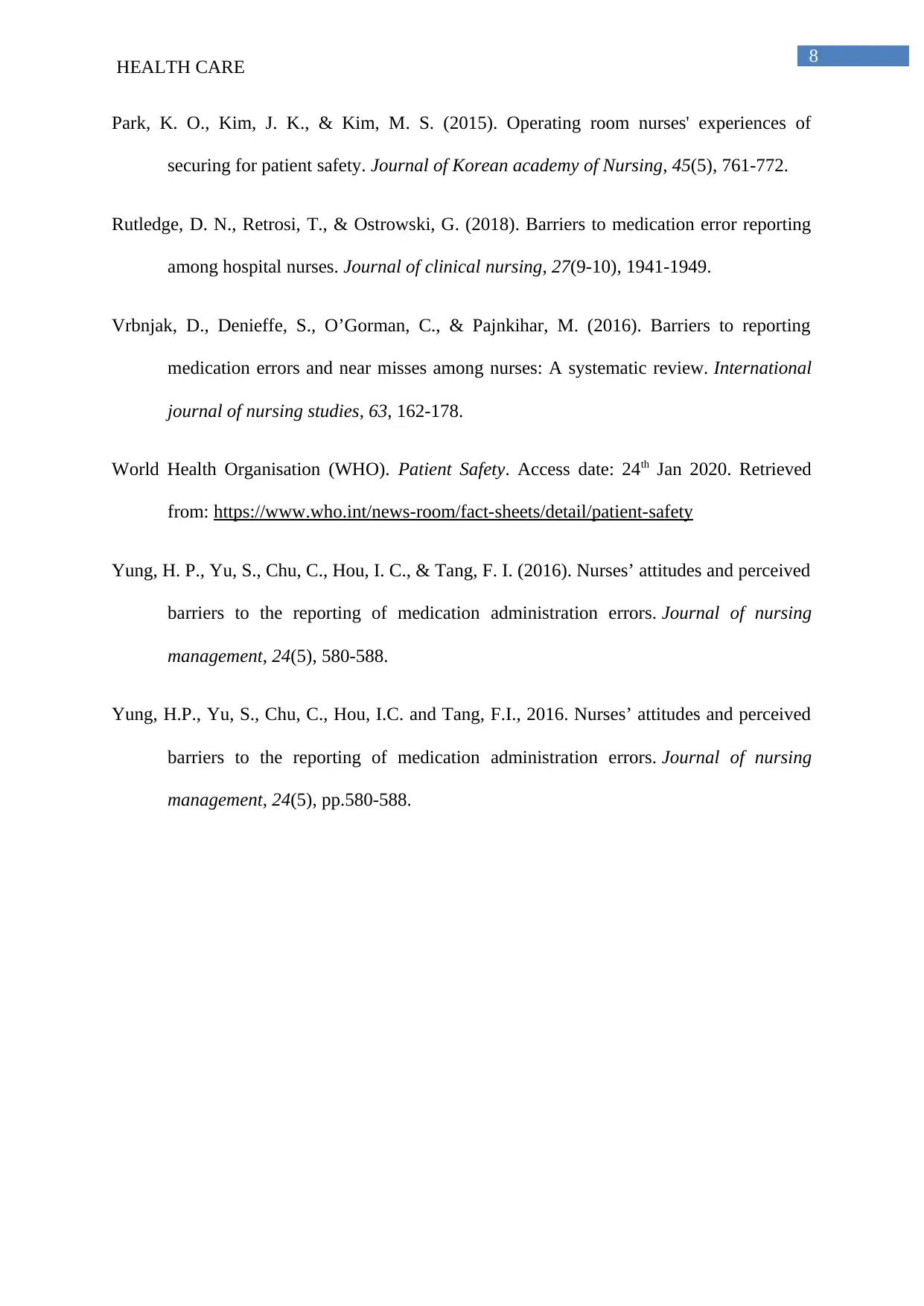
8
HEALTH CARE
Park, K. O., Kim, J. K., & Kim, M. S. (2015). Operating room nurses' experiences of
securing for patient safety. Journal of Korean academy of Nursing, 45(5), 761-772.
Rutledge, D. N., Retrosi, T., & Ostrowski, G. (2018). Barriers to medication error reporting
among hospital nurses. Journal of clinical nursing, 27(9-10), 1941-1949.
Vrbnjak, D., Denieffe, S., O’Gorman, C., & Pajnkihar, M. (2016). Barriers to reporting
medication errors and near misses among nurses: A systematic review. International
journal of nursing studies, 63, 162-178.
World Health Organisation (WHO). Patient Safety. Access date: 24th Jan 2020. Retrieved
from: https://www.who.int/news-room/fact-sheets/detail/patient-safety
Yung, H. P., Yu, S., Chu, C., Hou, I. C., & Tang, F. I. (2016). Nurses’ attitudes and perceived
barriers to the reporting of medication administration errors. Journal of nursing
management, 24(5), 580-588.
Yung, H.P., Yu, S., Chu, C., Hou, I.C. and Tang, F.I., 2016. Nurses’ attitudes and perceived
barriers to the reporting of medication administration errors. Journal of nursing
management, 24(5), pp.580-588.
HEALTH CARE
Park, K. O., Kim, J. K., & Kim, M. S. (2015). Operating room nurses' experiences of
securing for patient safety. Journal of Korean academy of Nursing, 45(5), 761-772.
Rutledge, D. N., Retrosi, T., & Ostrowski, G. (2018). Barriers to medication error reporting
among hospital nurses. Journal of clinical nursing, 27(9-10), 1941-1949.
Vrbnjak, D., Denieffe, S., O’Gorman, C., & Pajnkihar, M. (2016). Barriers to reporting
medication errors and near misses among nurses: A systematic review. International
journal of nursing studies, 63, 162-178.
World Health Organisation (WHO). Patient Safety. Access date: 24th Jan 2020. Retrieved
from: https://www.who.int/news-room/fact-sheets/detail/patient-safety
Yung, H. P., Yu, S., Chu, C., Hou, I. C., & Tang, F. I. (2016). Nurses’ attitudes and perceived
barriers to the reporting of medication administration errors. Journal of nursing
management, 24(5), 580-588.
Yung, H.P., Yu, S., Chu, C., Hou, I.C. and Tang, F.I., 2016. Nurses’ attitudes and perceived
barriers to the reporting of medication administration errors. Journal of nursing
management, 24(5), pp.580-588.
⊘ This is a preview!⊘
Do you want full access?
Subscribe today to unlock all pages.

Trusted by 1+ million students worldwide
1 out of 9
Related Documents
Your All-in-One AI-Powered Toolkit for Academic Success.
+13062052269
info@desklib.com
Available 24*7 on WhatsApp / Email
![[object Object]](/_next/static/media/star-bottom.7253800d.svg)
Unlock your academic potential
Copyright © 2020–2025 A2Z Services. All Rights Reserved. Developed and managed by ZUCOL.





